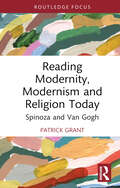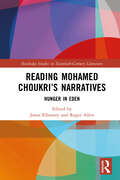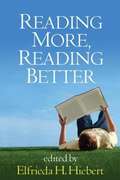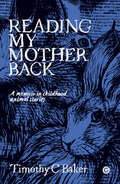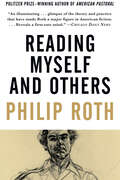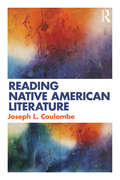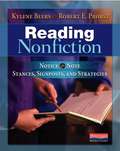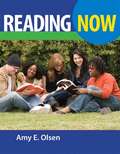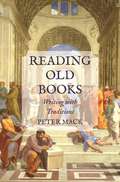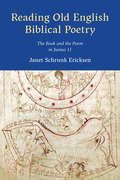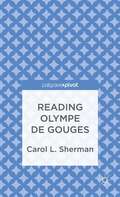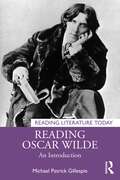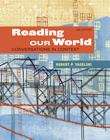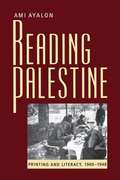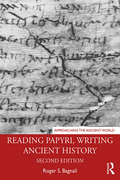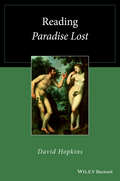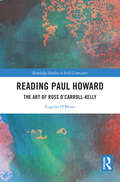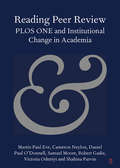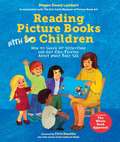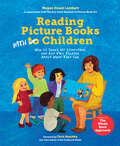- Table View
- List View
Reading Modernism with Machines
by Shawna Ross James O’sullivanThis book uses the discipline-specific, computational methods of the digital humanities to explore a constellation of rigorous case studies of modernist literature. From data mining and visualization to mapping and tool building and beyond, the digital humanities offer new ways for scholars to questions of literature and culture. With the publication of a variety of volumes that define and debate the digital humanities, we now have the opportunity to focus attention on specific periods and movements in literary history. Each of the case studies in this book emphasizes literary interpretation and engages with histories of textuality and new media, rather than dwelling on technical minutiae. Reading Modernism with Machines thereby intervenes critically in ongoing debates within modernist studies, while also exploring exciting new directions for the digital humanities--ultimately reflecting on the conjunctions and disjunctions between the technological cultures of the modernist era and our own digital present.
Reading Modernism with Machines: Digital Humanities and Modernist Literature
by Shawna Ross and James O’SullivanThis book uses the discipline-specific, computational methods of the digital humanities to explore a constellation of rigorous case studies of modernist literature.From data mining and visualization to mapping and tool building and beyond, the digital humanities offer new ways for scholars to questions of literature and culture. With the publication of a variety of volumes that define and debate the digital humanities, we now have the opportunity to focus attention on specific periods and movements in literary history. Each of the case studies in this book emphasizes literary interpretation and engages with histories of textuality and new media, rather than dwelling on technical minutiae. Reading Modernism with Machines thereby intervenes critically in ongoing debates within modernist studies, while also exploring exciting new directions for the digital humanities—ultimately reflecting on the conjunctions and disjunctions between the technological cultures of the modernist era and our own digital present.
Reading Modernity, Modernism and Religion Today: Spinoza and Van Gogh (Routledge Focus on Literature)
by Patrick GrantFeelings of rootlessness, fragmentation and loneliness are endemic in today’s secular societies. In the late nineteenth century, Émile Durkheim described this kind of social malaise as anomie, a concept this book locates within a historical narrative of the emergence of Modernism from Modernity. The book focuses on two representative figures, Benedictus de Spinoza and Vincent van Gogh, on whose works it offers significant new perspectives. Spinoza drew up a blueprint for Modernity, which is to say, the cultural transformations that took place as a result of the Scientific Revolution and the Protestant Reformation. In counterpoint to his overriding confidence in reason, a persistent current in Spinoza’s writing shows how concerned he was about a possible loss of confidence in his governing idea of a single Substance, the philosophical God, with which he sought to replace the creator God of the Bible. In promoting art as a means of filling the gap left by the absence of Spinoza’s philosophical God and the failures of traditional Christianity, Van Gogh also discovered the limitations of the vocation to which he had dedicated himself. He concluded that in the tension between art and anomie, a new kind of religious sensibility and understanding might emerge. This remains the case in the current postmodern cultural phase when fragmentation and incoherence are summoning up new assessments and re-configurations of values promoting new forms of solidarity, dialogue and religious understanding.
Reading Mohamed Choukri’s Narratives: Hunger in Eden (Routledge Studies in Twentieth-Century Literature)
by Roger Allen Jonas ElboustyReading Mohamed Choukri’s Narratives presents an intricate exploration into the life and literary universe of Mohamed Choukri, a towering figure in 20th-century Moroccan literature. Known primarily for his groundbreaking autobiographical work "al-Khubz al-Ḥāfī" (For Bread Alone), Choukri's literary influence extends well beyond this single work. This book seeks to cast a light on his broader body of work, examining the cultural, societal, and personal influences that shaped his unique storytelling style. Through a deep analysis of his narratives, this text aims to unfold how Choukri portrayed the harsh realities he and others encountered, giving voice to the marginalized individuals and communities in Morocco.
Reading More, Reading Better
by Elfrieda HiebertTeaching students specific literacy skills is important--but equally critical, and often overlooked, is giving them the time and opportunity to read actual texts. Bringing together leading scholars, this book focuses on how teachers can improve both the quality and quantity of reading experiences in K-12 classrooms. Essential topics include factors that make reading tasks more or less productive for different types of learners, ways to balance independent reading with whole-class and small-group instruction, how to choose appropriate texts, and the connections between reading engagement and proficiency. The relevant research literature is reviewed, and exemplary practices and programs are described.
Reading My Mother Back: A Memoir in Childhood Animal Stories
by Timothy C. BakerAn innovative memoir connecting ideas of grief, memory, and animals to illustrate the importance of storytelling.When his mother died, Timothy C. Baker discovered that there was almost no record of her existence, and no stories that were his to tell: the only way to bring her back was through reading. Reading My Mother Back is a genre-bending memoir that explores a life marked by trauma, illness, religion, and abuse through a focus on the books Baker and his mother shared. The book combines accounts of rereading childhood classics with true and apocryphal stories of a quiet life, marked by great sorrow and great joy. The book is about grief and memory and how our childhood reading shapes the way we see the world; it&’s about loneliness and the search for belonging; it&’s about how ordinary lives are transfigured by storytelling. Moving from accounts of American evangelical communities to kidney failure, from literary criticism to psychoanalysis, and from guilt to love, Baker shows how literature provides a framework for understanding our experiences, and offers a way of connecting with everything we have lost. The book illustrates how children&’s animal stories bring us into a love of the world, and how acts of rereading become a way not of assuaging grief, but of bringing the past and present together. Reading My Mother Back offers a bold and personal view of why the stories we read and share matter so much. And there are bunnies.
Reading Myself and Others (Vintage International)
by Philip RothFascinating interviews, essays, and articles spanning a quarter century on writing, baseball, American fiction, and American Jews—from the Pulitzer Prize-winning author of American Pastoral and one of the greatest writers of the 20th century. "An illuminating ... glimpse of the theory and practice that have made Roth a major figure in American fiction." —Chicago Daily News Here is Philip Roth on himself and his work and the controversies it's engendered. Here too are Roth's writings on the Eastern European writers he has always championed, and so much more. The essential collection of nonfiction by a true American master, Reading Myself and Others features his famed long interview with the Paris Review.
Reading Native American Literature
by Joseph L. CoulombeNative American literature explores divides between public and private cultures, ethnicities and experience. In this volume, Joseph Coulombe argues that Native American writers use diverse narrative strategies to engage with readers and are ‘writing for connection’ with both Native and non-Native audiences. Beginning with a historical overview of Native American literature, this book presents focused readings of key texts including: • N. Scott Momaday’s House Made of Dawn • Leslie Marmon Silko’s Ceremony • Gerald Vizenor’s Bearheart • James Welch’s Fool’s Crow • Sherman Alexie’s The Lone Ranger and Tonto Fistfight in Heaven • Linda Hogan’s Power. Suggesting new ways towards a sensitive engagement with tribal cultures, this book provides not only a comprehensive introduction to Native American literature but also a critical framework through which it may be read.
Reading Nonfiction: Notice and Note Signposts and Questions
by Kylene Beers Robert E. Probst"When students recognize that nonfiction ought to challenge us, ought to slow us down and make us think, then they're more likely to become close readers." That means we need to help them question texts, authors, and, ultimately, their own thinking. No matter the content area, with Reading Nonfiction's classroom-tested suggestions, you'll lead kids toward skillful and responsible disciplinary literacy. <P><P> Picking up where their smash hit Notice & Note left off, Kylene Beers and Bob Probst write: "Fiction invites us into the writer's imagined world; nonfiction intrudes into ours and purports to tell us something about it." This crucial difference increases the responsibility of the nonfiction reader, so Kylene and Bob have developed interlocking scaffolds that every student can use to go beyond a superficial reading: <P><P> <li>3 essential questions that set students up for closer, more attentive readings of nonfiction texts <li>5 Notice & Note nonfiction signposts that cue kids to apply the skills and processes that sophisticated readers use instinctively <li>7 proven strategies readers can use to clear up confusions when the text gets tough. <P><P> We all know the value of helping students define nonfiction and understand its text structures. Reading Nonfiction goes the next crucial step-helping kids challenge the claims of nonfiction authors, be challenged by them, and skillfully and rigorously make up their mind about purported truths.
Reading Now
by Amy E. OlsenReading Now engages students through thematic content to connect meaning with reading skill development and a richly illustrated design that delivers key concepts in an inviting way.
Reading Old Books: Writing with Traditions
by Professor Peter MackA wide-ranging exploration of the creative power of literary tradition, from Chaucer to the presentIn literary and cultural studies, "tradition" is a word everyone uses but few address critically. In Reading Old Books, Peter Mack offers a wide-ranging exploration of the creative power of literary tradition, from the middle ages to the twenty-first century, revealing in new ways how it helps writers and readers make new works and meanings.Reading Old Books argues that the best way to understand tradition is by examining the moments when a writer takes up an old text and writes something new out of a dialogue with that text and the promptings of the present situation. The book examines Petrarch as a user, instigator, and victim of tradition. It shows how Chaucer became the first great English writer by translating and adapting a minor poem by Boccaccio. It investigates how Ariosto, Tasso, and Spenser made new epic meanings by playing with assumptions, episodes, and phrases translated from their predecessors. It analyzes how the Victorian novelist Elizabeth Gaskell drew on tradition to address the new problem of urban deprivation in Mary Barton. And, finally, it looks at how the Kenyan writer Ngũgĩ wa Thiong'o, in his 2004 novel Wizard of the Crow, reflects on biblical, English literary, and African traditions.Drawing on key theorists, critics, historians, and sociologists, and stressing the international character of literary tradition, Reading Old Books illuminates the not entirely free choices readers and writers make to create meaning in collaboration and competition with their models.
Reading Old English Biblical Poetry: The Book and the Poem in Junius 11 (Toronto Anglo-Saxon Series)
by Janet Schrunk EricksenReading Old English Biblical Poetry considers the Junius 11 manuscript, the only surviving illustrated book of Old English poetry, in terms of its earliest readers and their multiple strategies of reading and makingmeaning. Junius 11 begins with the Creation story and ends with the final vanquishing of Satan by Jesus. The study is framed by particular attention to the materiality of the manuscript and how that might have informed its early reception, and it broadens considerations of reading beyond those of the manuscript’s compiler and possible patron. As a book, Junius 11 reflects a rich and varied culture of reading that existed in and beyond houses of God in England in the tenth and eleventh centuries, and it points to readers who had enough experience to select and find wisdom, narrative pleasure, and a diversity of other things within this orany book’s contents.
Reading Olympe de Gouges
by Carol L. ShermanOlympe de Gouges has been called illiterate, immoral, and insane while being mentioned solely for her Declaration of the Rights of Woman and the female] Citizen. This book uncovers her radical views of the self, the family, and the state and accounts for her vision of increasing female agency and decreasing the entitlements of aristocratic males.
Reading Oscar Wilde: An Introduction (Reading Literature Today)
by Michael Patrick GillespieReading Oscar Wilde is a comprehensive interpretive guide designed for students and readers who come to Wilde’s writings for the first time, delivering a fuller understanding of the works and the background from which the canon has emerged. This ready-at-hand compendium details the scholarly perspectives of Wilde’s vast literary output. Meticulously arranged, this accessible volume includes freestanding discussions of individual works, including clarification of Wilde’s pioneering contextual examinations and his innovative and influential stylistic achievements. Readers will find a solid foundation for understanding his works and will benefit from new insights into the impact of his writing on subsequent authors. Additionally, the surveys of the interpretive approaches offered by contemporary literary theories will highlight for readers a range of research possibilities. This book also includes lists of selected websites and artistic adaptations of Wilde’s works, a chronology of Wilde’s publications, and a comprehensive secondary bibliography to permit readers to develop both a wide-ranging background and a selective focus of interests.
Reading Our World: Conversations in Context (Second Edition)
by Robert P. YagelskiFor freshman composition courses in two- and four-year schools.
Reading Ovid
by Peter JonesPresents a selection of stories from Ovid's Metamorphoses, the most famous and influential collection of Greek and Roman myths in the world. It includes well-known stories like those of Daedalus and Icarus, Pygmalion, Narcissus and King Midas. The book is designed for those who have completed an introductory course in Latin and aims to help such users to enjoy the story-telling, character-drawing and language of one of the world's most delightful and influential poets. The text is accompanied by full vocabulary and grammar notes, with assistance based on two widely used beginners' courses, Reading Latin and Wheelock's Latin. Essays at the end of each passage point up important detail and show how the logic of each story unfolds, while study sections offer questions for discussion and ways of thinking further about the passage. No other intermediate text is so carefully designed to make reading Ovid a pleasure.
Reading Palestine: Printing and Literacy, 1900-1948
by Ami AyalonPrior to the twentieth century, Arab society in Palestine was predominantly illiterate, with most social and political activities conducted through oral communication. There were no printing presses, no book or periodical production, and no written signs in public places. But a groundswell of change rapidly raised the region's literacy rates, a fascinating transformation explored for the first time in Reading Palestine. <P><P> Addressing an exciting aspect of Middle Eastern history as well as the power of the printed word itself, Reading Palestine describes how this hurried process intensified the role of literacy in every sphere of community life. Ami Ayalon examines Palestine's development of a modern educational system in conjunction with the emergence of a print industry, libraries and reading clubs, and the impact of print media on urban and rural populations. Drawn from extensive archival sources, official reports, autobiographies, and a rich trove of early Palestinian journalism, Reading Palestine provides crucial insight into the dynamic rise of literacy that revolutionized the way Palestinians navigated turbulent political waters.
Reading Papyri, Writing Ancient History (Approaching the Ancient World)
by Roger S. BagnallSince its first publication in 1995, Reading Papyri, Writing Ancient History has proved to be an invaluable resource for students of the ancient world looking to integrate papyrological evidence into their research. In the quarter century since its publication, changes in the research environment have affected papyrology like other fields. Although the core philological methods of the field remain in place, the field has increasingly embraced languages other than Greek and Latin, with considerable impact on the Hellenistic and Late Antique periods. Digital tools have increased the ease and speed of access, with profound effects on research choices, and digital imaging and materiality studies have brought questions about the physical form of written materials to the fore. In this fully revised new edition, Bagnall adds to the previous analysis a portrait of how the use of papyri for historical research has developed during recent decades. Updated with the latest research and insights from the author, the volume guides historians in how to use these scattered and often badly damaged documents, and to interpret them in order to create a full and diverse picture of ancient society and culture. This second edition of Reading Papyri, Writing Ancient History continues to offer students and researchers of the ancient world a critical resource in navigating how to use these ancient texts in their research.
Reading Paradise Lost (Wiley Blackwell Reading Poetry)
by David HopkinsCasting a fresh perspective on the greatest long poem in English, David Hopkins guides the reader through the inspiring poetic landscape of Milton’s great epic Paradise Lost, a work of literature which has compelled and fascinated readers down the ages and which offers enduring insight into the human condition A welcome aesthetic focus on the poetic experience of reading Paradise Lost rather than its religious or political context Provides a nuanced, unified vision of the poem from a celebrated authority on English poetry of the period Includes consideration of the poem's earlier champions and critics Passionately advocates Paradise Lost's continuing artistic and philosophical relevance
Reading Paul Howard: The Art of Ross O'Carroll-Kelly (Routledge Studies in Irish Literature)
by Eugene O'BrienReading Paul Howard: The Art of Ross O’Carroll Kelly offers a thorough examination of narrative devices, satirical modes, cultural context and humour, in Howard’s texts. The volume argues that his academic critical neglect is due to a classic bifurcation in Irish Studies between high and popular culture, and will use the thought of Pierre Bourdieu, Sigmund Freud, Mikhail Bakhtin and Jacques Derrida to critique this division, building a theoretical platform from which to examine the significance of Howard’s work as an Irish comic and satirical writer. Addressing both the style and the substance of his work, this text locates him in a tradition of Irish satirical writing that dates back to the Gaelic bards, and includes writers like Swift, Wilde, Flann O’Brien and Joyce. Through textual and contextual analysis, this book makes the case for Howard as a significant and original voice in Irish writing, whose fusion of the three traditional types of satire (Horatian, Juvenalian and Menippean), has created a parallel Ireland that shines a satirical light on its real counterpart. As Freud suggests, humour is a way of accessing aspects of the psyche that normative discourses cannot enunciate, and Howard, through the confessional voice of Ross, offers a fictive truth on twenty years of Irish society, a truth that is not accessed by discourse in the public sphere or by what could be termed literary or high cultural fiction.
Reading Peer Review (Elements in Publishing and Book Culture)
by Samuel Moore Martin Paul Eve Cameron Neylon Daniel Paul O'Donnell Robert Gadie Victoria Odeniyi Shahina ParvinThis Element describes for the first time the database of peer review reports at PLOS ONE, the largest scientific journal in the world, to which the authors had unique access. Specifically, this Element presents the background contexts and histories of peer review, the data-handling sensitivities of this type of research, the typical properties of reports in the journal to which the authors had access, a taxonomy of the reports, and their sentiment arcs. This unique work thereby yields a compelling and unprecedented set of insights into the evolving state of peer review in the twenty-first century, at a crucial political moment for the transformation of science. It also, though, presents a study in radicalism and the ways in which PLOS's vision for science can be said to have effected change in the ultra-conservative contemporary university. This title is also available as Open Access on Cambridge Core.
Reading Picture Books with Children
by Megan Dowd LambertA new, interactive approach to storytime, The Whole Book Approach was developed in conjunction with the Eric Carle Museum of Picture Book Art and expert author Megan Dowd Lambert's graduate work in children's literature at Simmons College, offering a practical guide for reshaping storytime and getting kids to think with their eyes. Traditional storytime often offers a passive experience for kids, but the Whole Book approach asks the youngest of readers to ponder all aspects of a picture book and to use their critical thinking skills. Using classic examples, Megan asks kids to think about why the trim size of Ludwig Bemelman's Madeline is so generous, or why the typeset in David Wiesner's Caldecott winner,The Three Pigs, appears to twist around the page, or why books like Chris Van Allsburg's The Polar Express and Eric Carle's The Very Hungry Caterpillar are printed landscape instead of portrait. The dynamic discussions that result from this shared reading style range from the profound to the hilarious and will inspire adults to make children's responses to text, art, and design an essential part of storytime.
Reading Picture Books with Children: How to Shake Up Storytime and Get Kids Talking about What They See
by Megan Dowd LambertA new, interactive approach to storytime, The Whole Book Approach was developed in conjunction with the Eric Carle Museum of Picture Book Art and expert author Megan Dowd Lambert's graduate work in children's literature at Simmons College, offering a practical guide for reshaping storytime and getting kids to think with their eyes. Traditional storytime often offers a passive experience for kids, but the Whole Book approach asks the youngest of readers to ponder all aspects of a picture book and to use their critical thinking skills. Using classic examples, Megan asks kids to think about why the trim size of Ludwig Bemelman's Madeline is so generous, or why the typeset in David Wiesner's Caldecott winner,The Three Pigs, appears to twist around the page, or why books like Chris Van Allsburg's The Polar Express and Eric Carle's The Very Hungry Caterpillar are printed landscape instead of portrait. The dynamic discussions that result from this shared reading style range from the profound to the hilarious and will inspire adults to make children's responses to text, art, and design an essential part of storytime.
Reading Picture Books with Infants and Toddlers: Learning Through Language
by Jane TorrReading picture books with infants and toddlers facilitates their early language development, with far-reaching benefits for their later reading abilities and academic achievement. While the importance of reading books with children aged from 3 to 5 years is widely recognised, the benefits of reading with much younger children from 0 to 3 years, who are still engaged in learning their first language, are less well understood. This book will explore the seemingly simple practice of reading picture books with infants and toddlers aged 0–3 years, from a range of perspectives. Not only do book-focused adult–child interactions support language and early literacy development in multiple ways, such interactions can also, at the same time, foster intellectual, social, emotional, and spiritual growth. By weaving together in an accessible manner the insights from several different discipline areas, this book will explain how and why reading with infants and toddlers has such power to enrich their lives. Providing an evidence-based, theoretically informed account, Reading Picture Books with Infants and Toddlers supports educators, parents, and caregivers with the knowledge, skills, and motivation to provide frequent, enjoyable, and language-rich reading experiences with infants and toddlers.
Reading Piers Plowman
by Emily SteinerReading 'Piers Plowman' is an indispensable scholarly guide to a magnificent - and notoriously difficult - medieval poem. With Piers Plowman, the fourteenth-century poet William Langland proved that English verse could be at once spiritually electrifying and intellectually rigorous, capable of imagining society in its totality while at the same time exploring heady ideas about language, theology, and culture. In her study of Piers Plowman, Emily Steiner explores how Langland's ambitious poetics emerged in dialogue with contemporary ideas; for example, about political counsel and gender, the ethics of poverty, secular and pagan learning, lordship and servitude, and the long history of Christianity. Lucid and comprehensive, Steiner's study teaches us to stay alert to the poem's stunning effects while still making sense of its literary and historical contexts.

